|
|
|
Sort Order |
|
|
|
Items / Page
|
|
|
|
|
|
|
| Srl | Item |
| 1 |
ID:
094086


|
|
|
|
|
| Publication |
2010.
|
| Summary/Abstract |
The landscape of the global economy is dotted with institutions that regulate investment and trade. in recent years, the number of bilateral investment treaties (BITs) and preferential trade agreements (PTAs), in particular, has grown at a torrid pace; practically every country is a member of at least one-if not many-of these institutions. For all the scholarly attention that these institutions have received, however, there is little research tying BITs and PTAs together. this is surprising, since both aim to increase commerce by making it more predictable. The authors seek to fill this gap in the literature. They argue that a BIT between a developed and a developing country should make it more likely that this pair of states will subsequently form a PTA. that said, the wrinkle in the story is that more is not better in this regard; the authors further argue that a developing country that has many BITs is less likely to conclude a PTA with a wealthy state. The authors test these hypotheses using annual data on pairs of developing and developed countries between 1960 and 2004 and find strong evidence in support of their argument.
|
|
|
|
|
|
|
|
|
|
|
|
|
|
|
|
| 2 |
ID:
175855
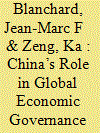

|
|
|
|
|
| Summary/Abstract |
A large proportion of debates about China’s impacts on global economic governance lack systematic empirical analysis. We engage the debate about if China is a revolutionary, revisionist, or status quo state through a deep dive into China’s behaviors with respect to Bilateral Investment Treaties (BITs). This research strategy is à propos because BITs represent the de facto regime governing foreign direct investment (FDI) globally, and China is the world’s second largest signatory of BITs. Drawing upon a database that we created using material on BITs available from the United Nations Conference on Trade and Development, we systematically examine the substantive and procedural provisions of China’s BITs from 2000 onward. Using a qualitative methodology discussed in-depth in our article, we also put China’s BIT practices in comparative perspective by comparing them against the BIT practices of Japan, a leading developed economy with BIT practices reflecting those of other established economies. Our multivariate analysis demonstrates China is not a revolutionary or dramatically revisionist player with respect to BITs. It champions positions that are neither hyper-conservative (state friendly) nor hyper-liberal (FDI friendly). To be more precise, China’s policies, especially with respect to substantive provisions, tend to be conservative, with, to some extent, some liberal aspects. Our analysis, then, indicates that commentators, businesspeople, and policymakers should be cautious about proffering claims that China is dramatically reshaping global economic governance. Aside from this important contribution to the debate, our work also expands knowledge about China’s BITs specifically and BITs generally, which does not reflect adequate attention to BITs from East Asian countries.
|
|
|
|
|
|
|
|
|
|
|
|
|
|
|
|
| 3 |
ID:
075221


|
|
|
|
|
| Publication |
2006.
|
| Summary/Abstract |
Over the past forty-five years, bilateral investment treaties (BITs) have become the most important international legal mechanism for the encouragement and governance of foreign direct investment. The proliferation of BITs during the past two decades in particular has been phenomenal. These intergovernmental treaties typically grant extensive rights to foreign investors, including protection of contractual rights and the right to international arbitration in the event of an investment dispute. How can we explain the widespread adoption of BITs? We argue that the spread of BITs is driven by international competition among potential host countries-typically developing countries-for foreign direct investment. We propose a set of hypotheses that derive from such an explanation and develop a set of empirical tests that rely on network measures of economic competition as well as more indirect evidence of competitive pressures on the host to sign BITs. The evidence suggests that potential hosts are more likely to sign BITs when their competitors have done so. We find some evidence that coercion and learning play a role, but less support for cultural explanations based on emulation. Our main finding is that the diffusion of BITs is associated with competitive economic pressures among developing countries to capture a share of foreign investment. We are agnostic at this point about the benefits of this competition for development.
|
|
|
|
|
|
|
|
|
|
|
|
|
|
|
|
| 4 |
ID:
120166


|
|
|
|
|
| Publication |
2013.
|
| Summary/Abstract |
Some treaties are signed and then ratified quickly while others languish in legal limbo, unratified by one or more parties. What explains this variation in the time between signature and ratification? The international relations literature has not taken the ratification stage seriously enough, despite its obvious importance from a legal and a political perspective. We offer a systematic study of this question in the context of bilateral investment treaties. We develop and test a set of theoretical propositions related to domestic-level constraints on the executive, the varying ability of governments to rationally anticipate ratification obstacles, and the bilateral relationship between treaty partners. We generally find support for these propositions but report some surprising findings as well. The article presents implications for investment agreements and treaty making more generally, and raises a number of issues for further study at the intersection of international politics and law.
|
|
|
|
|
|
|
|
|
|
|
|
|
|
|
|
| 5 |
ID:
170996


|
|
|
|
|
| Summary/Abstract |
As the Belt and Road Initiative expands the global footprint of Chinese firms, Beijing increasingly relies on international law to protect investments overseas. How and why has China's engagement with the international investment regime evolved over the past four decades? This article addresses these questions by examining the central component of the international investment regime: bilateral investment treaties (BITs). Through analyzing China's BIT practice and the security exceptions in 1,173 BITs concluded by both China as well as its treaty partners, this article provides evidence of changing Chinese engagement, from cautious interaction (1978–1991) to active participation (1992–1997), committed implementation (1998–2012), and mature influence (2013–present). As Beijing accepted, applied, and shaped the rules and norms of the BIT system, China's treaty practice co-evolved with the international investment regime. A co-evolutionary approach illuminates why—and how—state behaviour and international orders change over time.
|
|
|
|
|
|
|
|
|
|
|
|
|
|
|
|
| 6 |
ID:
072142
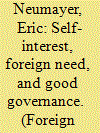

|
|
|
|
|
| Publication |
2006.
|
| Summary/Abstract |
Bilateral investment treaties (BITs) have become the most important legal mechanism for the encouragement and governance of foreign direct investment (FDI) in developing countries. Yet practically no systematic evidence exists on what motivates capital-exporting developed countries to sign BITs earlier with some developing countries than with others, if at all. The theoretical framework from the aid allocation literature suggests that developed countries pursue a mixture of self-interest, foreign need and, possibly, good governance. We find evidence that both economic interests of developed countries' foreign investors and political interests of developed countries determine their scheduling of BITs. However, foreign need as measured by per capita income is also a factor, whereas good governance by and large does not matter. These results suggest that BIT programs can be explained using the same framework successfully applied to the allocation of aid. At the same time, self-interest seems to be substantively more important than developing country need when it comes to BITs.
|
|
|
|
|
|
|
|
|
|
|
|
|
|
|
|
| 7 |
ID:
124394
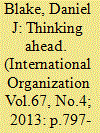

|
|
|
|
|
| Publication |
2013.
|
| Summary/Abstract |
International institutions help governments make credible commitments to other state and nonstate actors by raising the costs of commitment violation. However, in doing so these institutions generate sovereignty costs for national governments by constraining the autonomy they have to develop and implement policy. Governments respond to this trade-off between the credibility of commitments and policy autonomy differently depending on their time horizons and this shapes their preferences over the design of credibility-enhancing institutions. Governments with long time horizons expect to govern in the future, anticipate that conditions may shift over time, and therefore seek institutional designs that will afford them greater freedom to modify policies in response to changing economic and political conditions. Governments with shorter time horizons, on the other hand, do not anticipate being in power long into the future and therefore are less concerned about maintaining greater room to manipulate policy. I develop this argument in the context of bilateral investment treaties (BITs), focusing in particular on the legalization of obligation in national treatment commitments. I test the argument using an original data set of the design of national treatment obligations in a random sample of 342 BITs. I find that net importers of FDI with longer time horizons are more likely to build in greater policy autonomy in their BITs by scaling back the legalization of their national treatment obligations and that this relationship is robust to controlling for selection into investment treaties.
|
|
|
|
|
|
|
|
|
|
|
|
|
|
|
|
| 8 |
ID:
174853


|
|
|
|
|
| Summary/Abstract |
This article empirically examines various factors affecting the formation of China’s bilateral investment treaties (BITs) since 1978. Using a panel data analysis, this article finds that domestic and foreign relationship as well as foreign country and global factors, help explain the signing of BITs. Specifically, China’s trade openness and economic growth, foreign countries’ level of democracy, and socialization are positively related to the signing of BITs, while foreign economic growth and the distance between two countries are negatively related to the signing of BITs. Generally, this article finds that China signs BITs mainly to attract foreign capital, signaling to foreign investors that it protects their rights in China. Meanwhile, China has been less likely to sign BITs with countries with which it enjoys favorable bargaining position. As this article finds, China is more likely to sign BITs with democratic countries, suggesting that global spread of democracy spread globalization.
|
|
|
|
|
|
|
|
|
|
|
|
|
|
|
|
| 9 |
ID:
156248
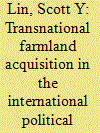

|
|
|
|
|
| Summary/Abstract |
A new wave of transnational farmland acquisition recently emerged, giving rise to two questions: What are the approaches in this wave of farmland acquisition and have relevant regulations been created for governance? Theories of international political economy are used to analyze the acquisition race, with two findings. First, grain-importing countries in Asia and the Persian Gulf region tend to use economic nationalism to conduct acquisition. Developed countries in the West tend towards liberalism, with market interests being the driving force behind acquisition, and the civil society of host countries in the South generally embrace both Marxism and liberalism, hoping to evaluate the acquisition process from perspectives of human rights and responsible farmland investment. Second, the existing governance regulations tend to favor investor countries’ interests, leaving host countries’ food security insufficiently protected.
|
|
|
|
|
|
|
|
|
|
|
|
|
|
|
|
| 10 |
ID:
176038


|
|
|
|
|
| Summary/Abstract |
When negotiating investment treaties, states balance two goals: providing strong protections for investors (investor protection), which is thought to attract foreign direct investment, and maintaining the ability to regulate their economies (regulatory autonomy). In this article we argue that treaty content can tell us about the latent preferences that states have over the level of investor protection enshrined in BITs. We use an item response theory (IRT) model and a dataset of 1,144 treaties to estimate latent preferences on this scale for signatory countries. Our measure is of use to scholars interested in studying bilateral investment treaties, international law, and foreign direct investment, and our model is of use to anyone aiming to estimate latent preferences from jointly produced manifestations.
|
|
|
|
|
|
|
|
|
|
|
|
|
|
|
|
| 11 |
ID:
119692


|
|
|
|
|
| Publication |
2013.
|
| Summary/Abstract |
Using the international investment regime as its point of departure, the article applies notions of bounded rationality to the study of economic diplomacy. Through a multimethod approach, it shows that developing countries often ignored the risks of bilateral investment treaties (bits) until they themselves became subject to an investment treaty claim. Thus the behavior of developing country governments with regard to the international investment regime is consistent with that routinely observed for individuals in experiments and field studies: they tend to ignore high-impact, low-probability risks if they cannot bring specific "vivid" instances to mind.
|
|
|
|
|
|
|
|
|
|
|
|
|
|
|
|
| 12 |
ID:
087574
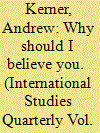

|
|
|
|
|
| Publication |
2009.
|
| Summary/Abstract |
Bilateral Investment Treaties (BITs) are the primary legal mechanism protecting foreign direct investment (FDI) around the world. BITs are thought to encourage FDI by establishing a broad set of investor's rights and by allowing investors to sue a host state in an international tribunal if these rights are violated. Perhaps surprisingly, the empirical literature connecting BITs to FDI flows has produced conflicting results. Some papers have found that BITs attract FDI, while others have found no relationship or even that BITs repel FDI. I suggest in this paper that these results stem from statistical models that do not fully capture the causal mechanisms that link BITs to FDI. Extant literature has often suggested that BITs may encourage investment from both protected and unprotected investors, yet the literature has not allowed for a full evaluation of this claim. This paper explores the theoretical underpinnings and empirical implications of an institution that works in these direct and indirect ways, and offers a statistical test that is capable of distinguishing between the two. The results indicate that: (1) BITs attract significant amounts of investment; (2) BITs attract this investment from protected and unprotected investors; and (3) these results are obscured by endogeneity unless corrected for in the statistical model.
|
|
|
|
|
|
|
|
|
|
|
|
|
|
|
|
|
|
|
|
|